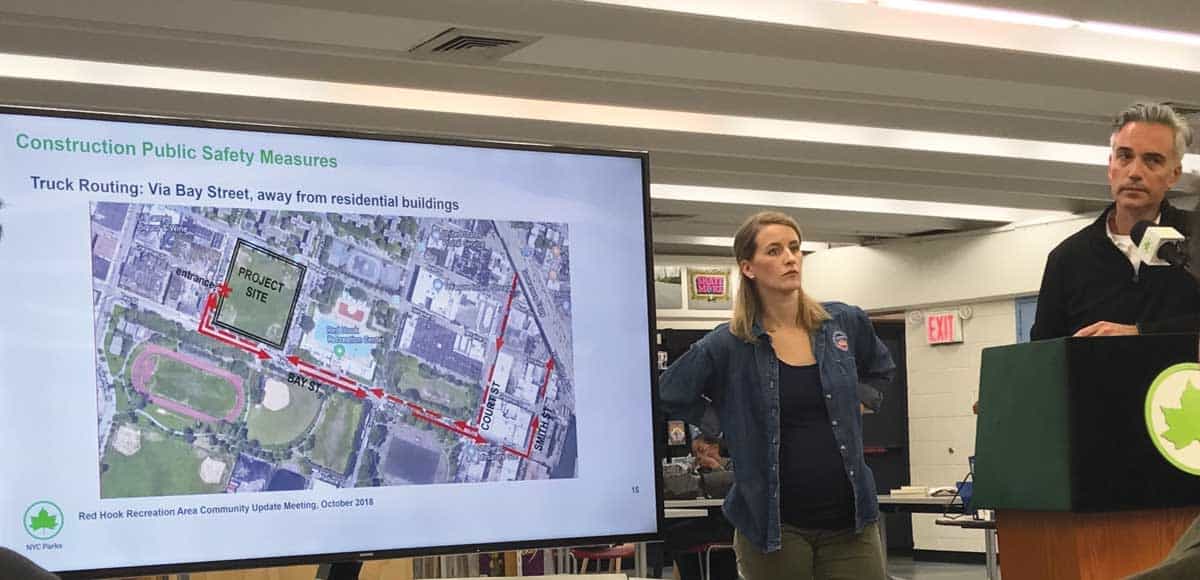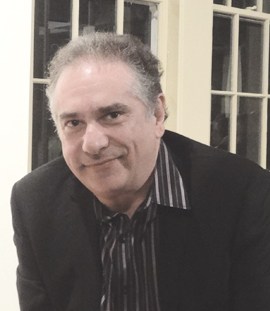
Key updates from the Red Hook Recreation Area Ballfields community update meeting, held on October 25:
The eight existing handball courts, located nearby the corner of Bay and Columbia Streets, will remain and be reconstructed. This follows community suggestions made at Community Board 6’s Parks & Recreation/Environmental Protection committee meeting in mid-September. The proposed plan was to originally keep and reconstruct four handball courts and remove the other four to make way for a new basketball court.
Red Hook Ballfields 5-8, adjacent to the Red Hook Recreation Center, were originally closed in Spring 2015 after soil samples showed elevated lead levels from the former Columbia lead smelting facility. They will be cleaned up by the NYC Department of Parks and Recreation (NYC Parks) under formal U.S. Environmental Protection Agency (EPA) oversight. According to the EPA Community Update No. 9 handout, these activities will include: installing perimeter fencing; cutting down trees along Bay, Hicks, and Henry Streets; staging materials on the ball fields; installing tree guards; and placing temporary construction trailers along Bay and Hicks Streets. NYC Parks will also remove the top layer of soil, place a visual barrier over the contaminated soil and cover the barrier with up to one foot of clean soil or other material.
“There’s going to be a retaining wall around all the fields, and a demarcation layer over the contaminated soil that’ll be left in place. Above that is going to be clean-fill, drainage and synthetic turf on top,” said EPA’s Margaret Gregor, the original project manager on the technical side in 2014. “This was the result of scoping meetings that Parks held to hear what the community wanted, what the concerns were, and what would be the best thing for this particular area.”
Eric Mattes, the Brooklyn Landscape Architecture Director for NYC Parks, later explained that the ball fields are going to be raised above flood elevation – the equivalent of about three feet. As a result, bioswales (planted areas along the fields that collect stormwater that runs off fields when it rains) will be added around the site’s perimeter, directly adjacent to the fields and retaining walls. He also told those in attendance that 62 new trees, 900 shrubs, 5000+ perennials and ornamental grasses would be planted.
Mattes said approximately 4,900 cubic yards of contaminated materials will be removed, and about 10,900 cubic yards of clean fill and drainage aggregate will be brought onto the site. Based on those numbers, an estimated 500-600 trucks will be transporting materials to and from approved waste disposal facilities – which are currently undetermined at this point in time. The truck route established with the site’s contractor would mainly be along Bay Street (from Hicks to Smith Streets), with the intent of being kept away from as many residential buildings as possible. However, the exact truck route to and from Red Hook is unknown at this time. Mattes explained that there will be a double handling of soil, in which licensed trucks with materials would be loaded and driven on local streets and then unloaded at a pier.
Currently there are no city-owned lots or appropriately licensed waste transfer piers near the site. It was also explained at the public meeting that barging is not feasible at Henry Street Basin: the land beneath the basin is privately owned; the water depth is shallow; and the city-owned bulkhead is in disrepair.
Because these daytime construction activities will generate dust, there will be continuous perimeter dust monitoring via soil pile tarps, frequent spraying of exposed areas with water, and perimeter fencing dust curtains. The air will also be monitored throughout the cleanup to protect people’s health. Construction is expected to start later this fall and be completed by Spring 2020.
Council Member Carlos Menchaca, who was in attendance, closed the evening’s meeting, saying he would like to request the Department of Transportation (DOT) to come to the next meeting and provide responses to truck flow-related questions.
“I think those questions have to be answered,” he said. “It’s unfair because Parks doesn’t have to do that part, but DOT does, and DOT should be able to answer those questions.”
For details regarding the cleanup process, visit EPA’s website at epa.gov/superfund/columbia-smelting. The EPA has also established an Information Repository at the Red Hook Branch of the Brooklyn Public Library (7 Wolcott St.), where the public can review and copy records related to EPA’s investigation and the cleanup of Ball Fields 5-9. For more information about plans for other fields within Red Hook Park, visit nycgovparks.org/about/whats-happening/red-hook-park-remediation.
Author
-

George Fiala has worked in radio, newspapers and direct marketing his whole life, except for when he was a vendor at Shea Stadium, pizza and cheesesteak maker in Lancaster, PA, and an occasional comic book dealer. He studied English and drinking in college, international relations at the New School, and in his spare time plays drums and fixes pinball machines.
View all posts
George Fiala has worked in radio, newspapers and direct marketing his whole life, except for when he was a vendor at Shea Stadium, pizza and cheesesteak maker in Lancaster, PA, and an occasional comic book dealer. He studied English and drinking in college, international relations at the New School, and in his spare time plays drums and fixes pinball machines.









